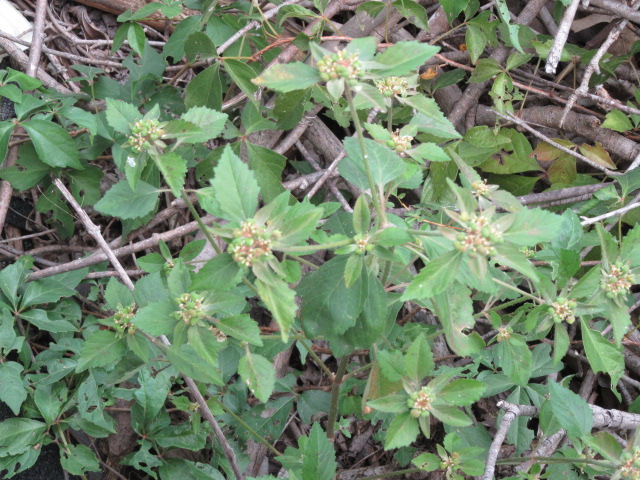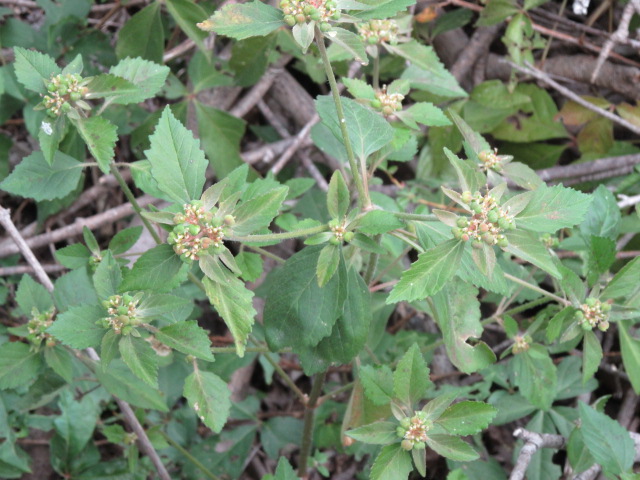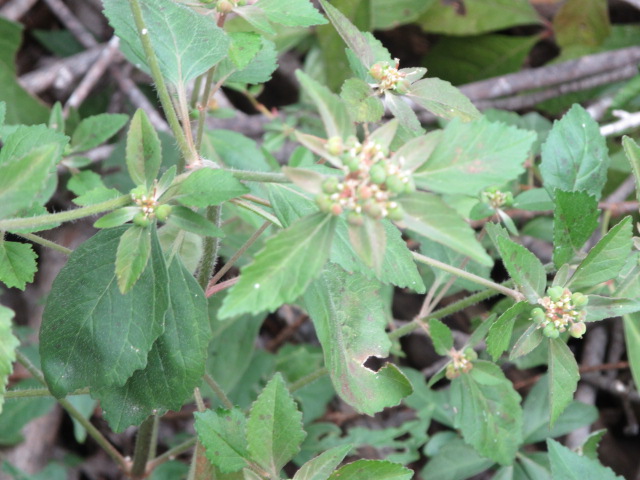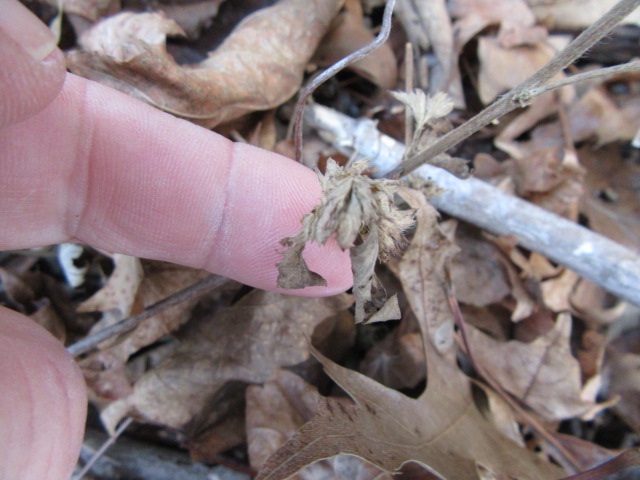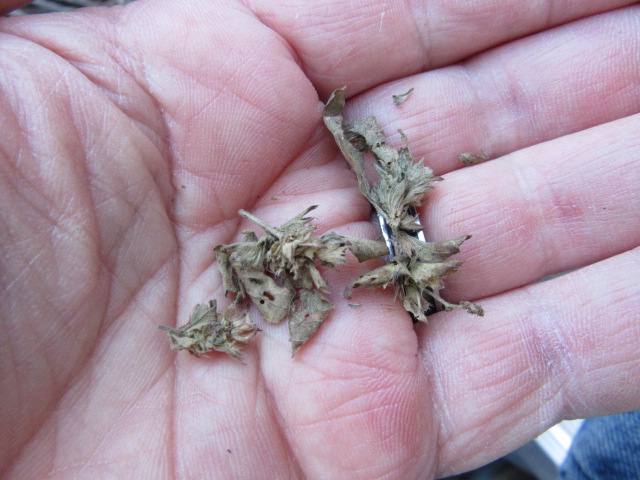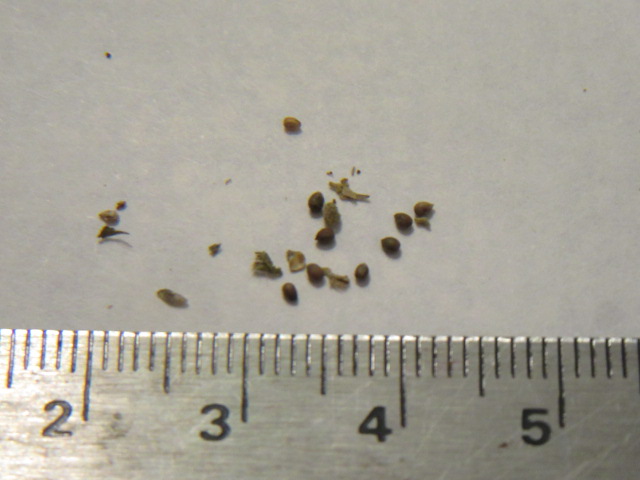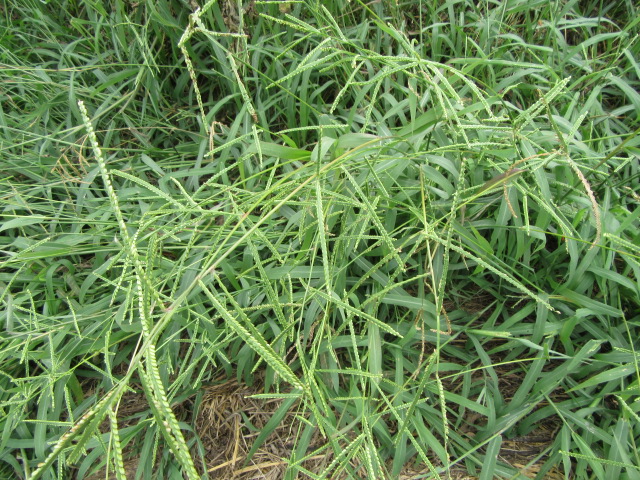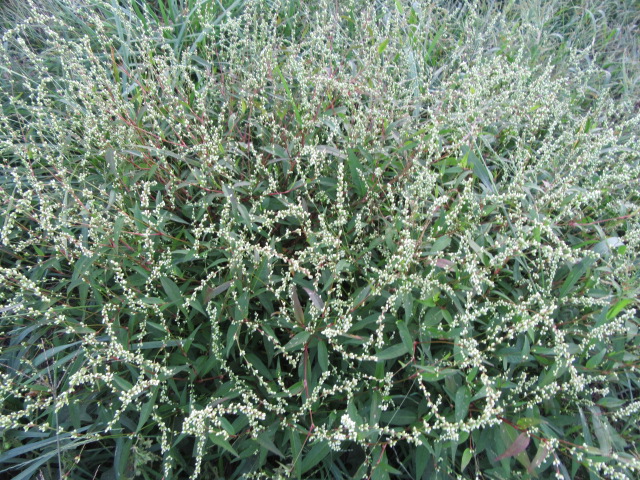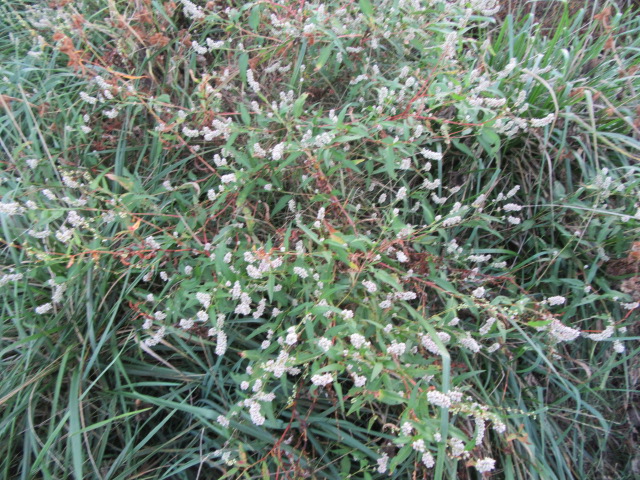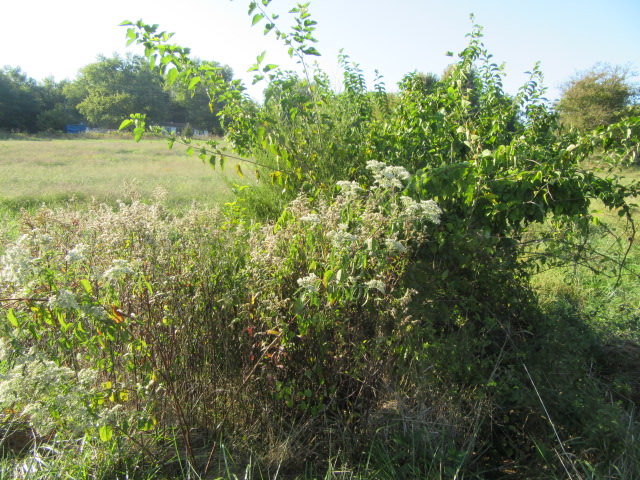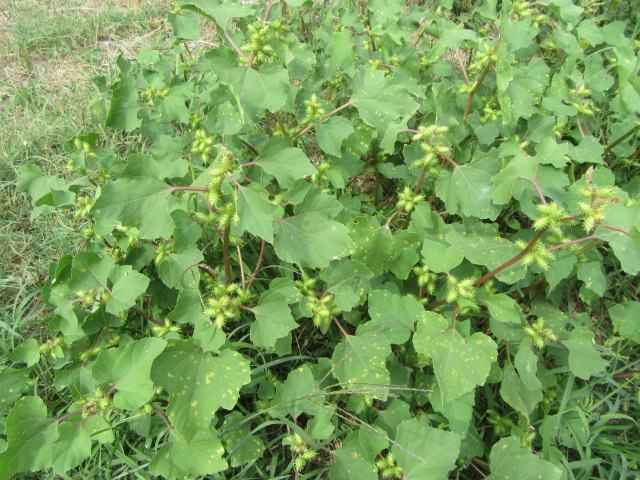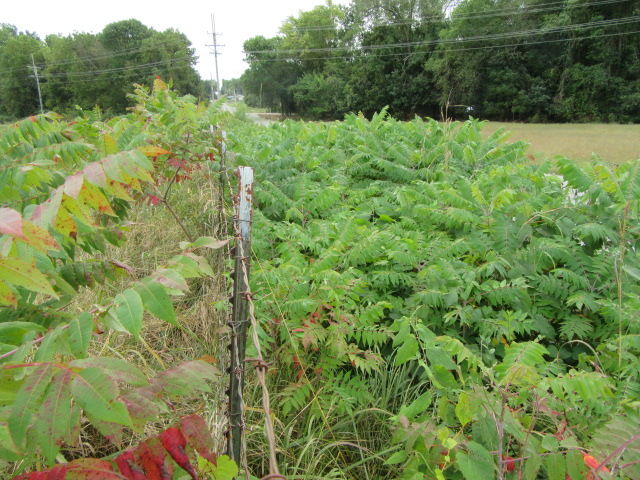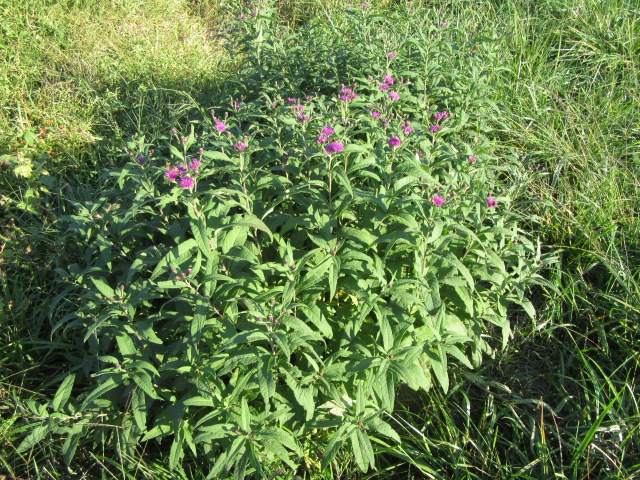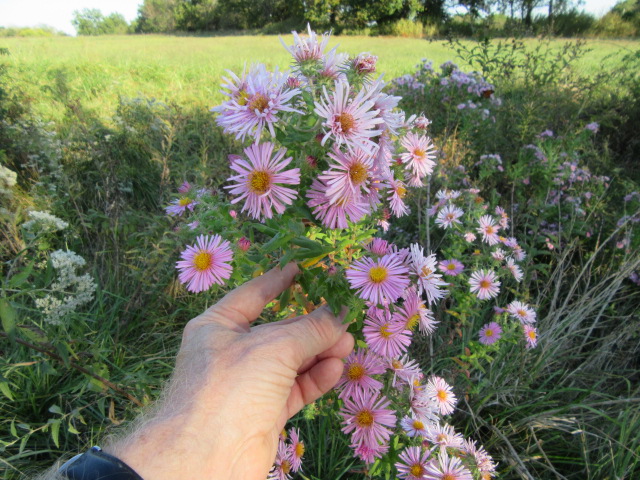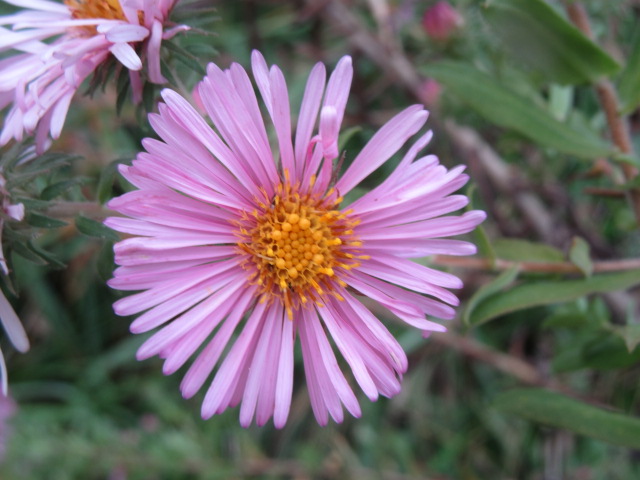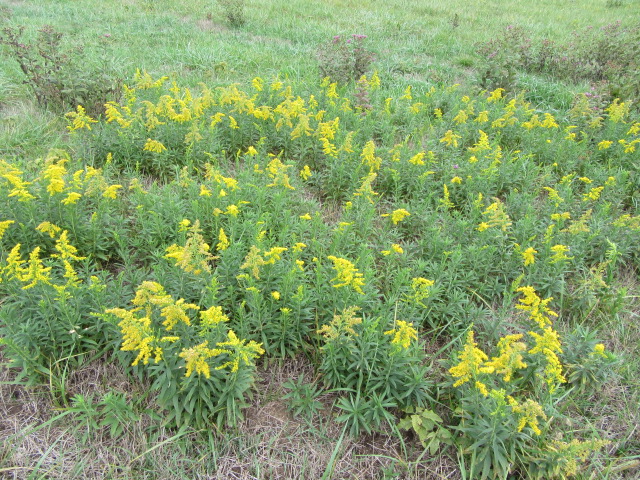
Solidago sp. (Goldenrod) in the main hayfield on 10-24-21, #851-8.
Hello everyone! This is not exactly a normal time of the year to be identifying wildflowers on the farm here in west-central Missouri. Normally, we have had an “F” by now and most everything is dead or dying. Trees that turn bright colors, like many maple cultivars, are still green. The old maple in “the other yard” is changing color and the leaves are falling, but they would normally be orange. The two maples in front of the house and the south side are still green… Here it is, October 25, and still no “F” in the forecast… I am certainly not complaining. 🙂
I went to the south hayfield on October 24 to look at the Ladies’ Tresses again. I was also hoping I would stumble on the Elephant’s Foot again which didn’t happen (at least not in the south hayfield). The flowers of Ladies’ Tresses were beginning to fade, so what I was looking for apparently didn’t happen. I am still leaning toward Spiranthes magnicamporum even though their lateral sepals didn’t spread outward. I think the flowers the way they are and the stems with the sheathing bracts are good enough to confirm identity.
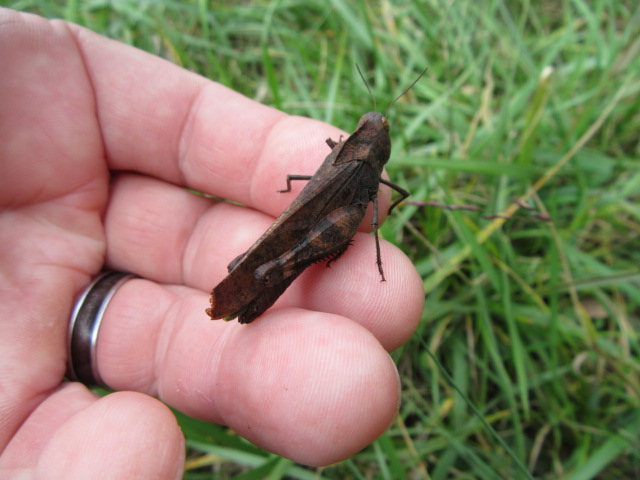
Arphia xanthoptera (Autumn Yellow-Winged Grasshopper) on 10-24-21, #851-6.
I walked to the back of the south hayfield to see if there was anything interesting and I spotted this brown grasshopper. Its scientific identity is Arphia xanthoptera and the common name is Autumn Yellow-Winged Grasshopper. I had never seen a grasshopper this color, but photos of the species show they come in many shades. I was surprised it actually let m hold it for a while. Usually, grasshoppers move around to the other side of a stem or leaf so you won’t see them. If you get too close they just fly off. This fellow didn’t seem to mind sitting on my hand to get a photo. After that, it left its calling card and flew off. As he flew, I could see his wings were red and yellow.
I am in an argument with Grammarly at the moment… I know we are both right and wrong at the same time. Grammarly thinks I shouldn’t capitalize the name on both sides of the hyphen, but that is the way I always do it. If a person’s name includes a hyphen, both names are capitalized. We are both wrong because some well-paid taxonomists think common names shouldn’t be capitalized at all. Other taxonomists are in disagreement. According to “some”, even family names shouldn’t be italicized and others yes… I capitalize common names and italicize family names and so do most of the sites I use.
After I finished in the south hayfield I climbed over the fence and entered the main hayfield. Not long after I was in the main hayfield, I stumbled on a strange plant I hadn’t seen before.
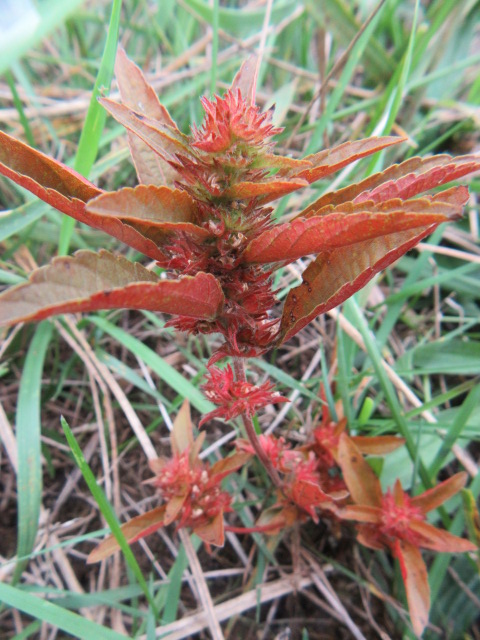
Acalypha gracilens (Slender Three-Seeded Mercury) on 10-24-21, #851-2.
It was quite windy so I had to take even more photos than normal. This Acalypha gracilens (Slender Three-Seeded Mercury) was sticking out like a sore thumb adorned in its fall colors. I had never seen it before, so I knew I had identified a new species on the farm. That is always exciting. I knew it was a member of the plant family Euphorbiaceae and I was correct. I only noticed one plant on the 24th but I needed a few more photos so I went back on the 25th. I couldn’t find the exact plant, but I managed to find two more. The second plant I found was only 4 1/4″ tall but the one from the 24th seemed a little larger. They can actually grow to 36″ tall…
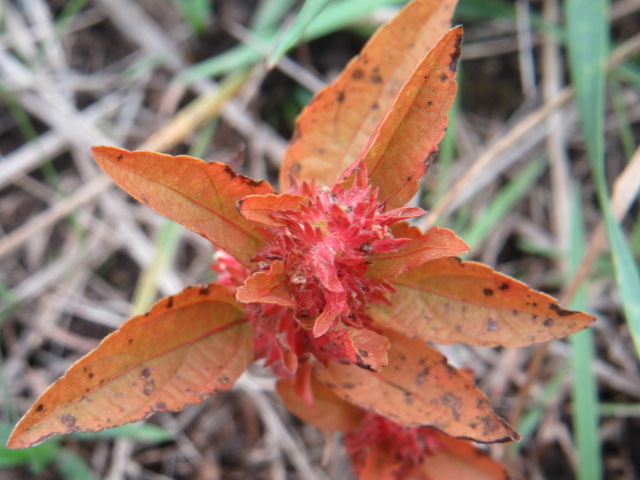
Acalypha gracilens (Slender Three-Seeded Mercury) on 10-25-21, #852-3.
The Acalypha gracilens is a native of the southeastern and east part of the United States. It is quite common in some states and quite rare in others. It only has a few observations in the state of Missouri and none anywhere near here.
Plants grow in a variety of soil and light conditions which makes them very adaptable. In some situations, they can become weedy and grow differently from location to location making them somewhat tricky to identify.
The plants produce both male and female flowers on the same raceme. The female flowers are on the lower part while the male flowers are on the upper part. Flowers are wind pollinated and they become more “obvious” after pollination… Hmmm… We have had plenty of wind lately so they should be happy. This species produces fruit with 3 sections with one seed per section. There is a name for that but I can’t think of it at the moment. It is believed the seeds are dispersed by explosion or by ants. Of course, there were no seeds when I took the photos so I couldn’t give it a try. I guess that gives me a reason to go back to experiment. 🙂
I am working on the page for this plant…
<<<<+>>>>
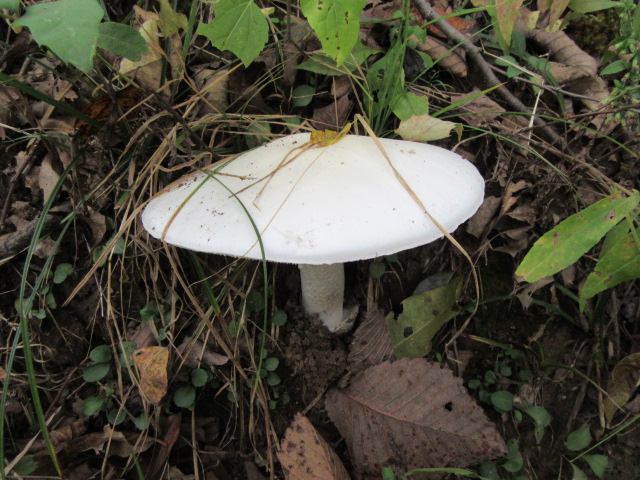
Amanita bisporigera (Eastern North American Destroying Angel) on 10-24-21, #851-4.
While behind the back pond, no one could help but notice the Amanita bisporigera (Eastern North American Destroying Angel) along the creek on the other side of the fence. There were several on top of the bank, but the biggest was growing on the side.
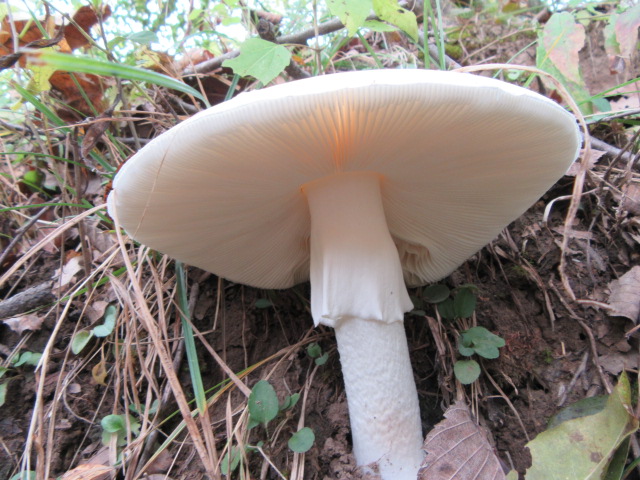
Amanita bisporigera (Eastern North American Destroying Angel) on 10-24-21, #851-5.
This fungi is not one you would want to try in your favorite spaghetti sauce. If you eat it, you will start feeling ill in no time but then you will begin to feel better. The damage has already been done and you will die within 4-6 days…
<<<<+>>>>
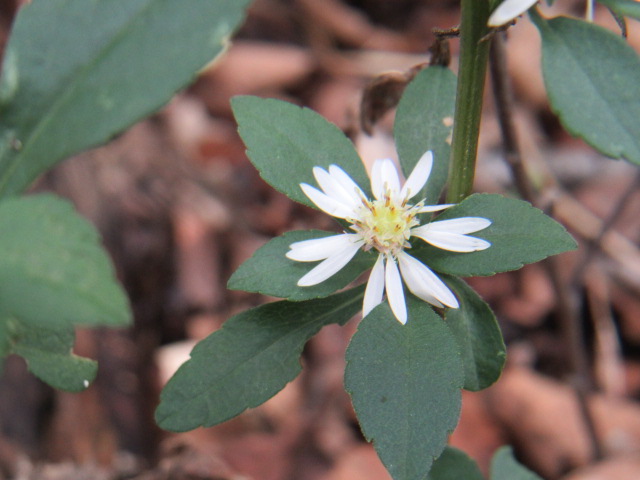
Symphyotrichum sp. ? on 10-24-21, #851-12.
By now you will know my confusion when it comes to several members of the Symphyotrichum genus. I found several of these plants growing on both sides of a drainage ditch behind the pond in the back pasture. Right off, I knew I hadn’t identified this one before. I was kind of excited but I soon realized I was going to be in a predicament… Here is a member of the aster family, likely a species of Symphyotrichum with leaves that resemble a species of Erigeron… Why in the heck are there single flowers growing on top of clusters of leaves like that?
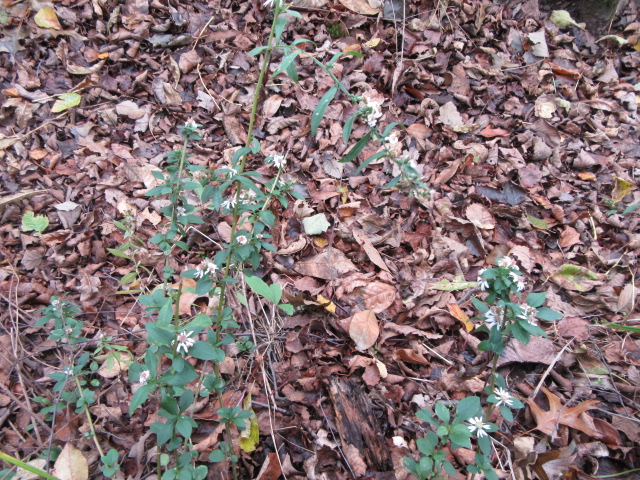
Symphyotrichum sp. ? on 10-24-21, #851-10.
It made absolutely no sense to me at all… Later, I went back to the house and went through the photos for the day, and uploaded the observations on iNaturalist. When I got to these photos, INaturalist suggested Symphyotrichum drummondii… I checked out that species on Missouri Plants and a few other sites linked on Wildflower Search and couldn’t see any resemblance as far as the leaves were concerned. I checked out the other suggestions the list and had the same opinion… The leaves on those species were fairly long and narrow and some of the flowers weren’t right either.
Then I looked at the photos I took and noticed something…
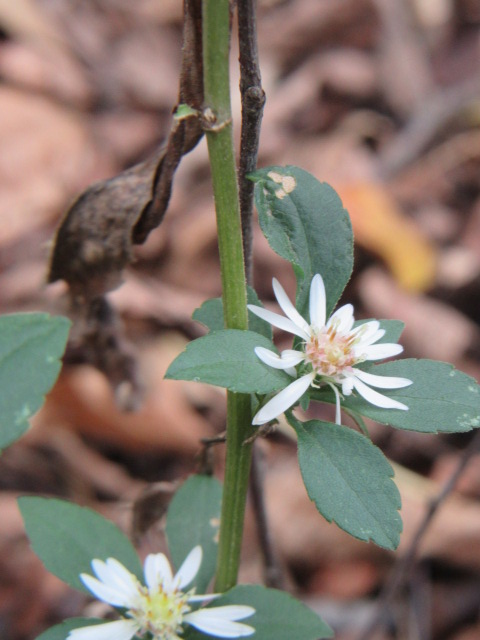
Symphyotrichum sp. ? on 10-24-21, #851-13.
What in the heck is that dead leaf dangling from the stem on this photo? Hmmm… By then it was too late to go to the back of the farm to check. I suppose I could have taken a flashlight.
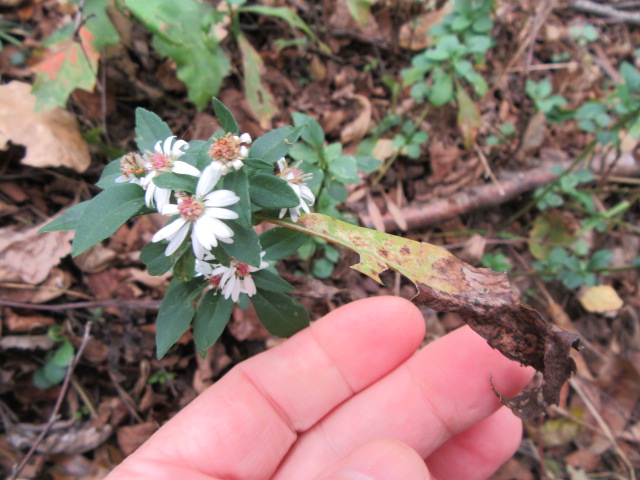
Symphyotrichum sp. ? on 10-25-21, #852-18.
Would you look at that!?!? It’s a long, narrow leaf! Sometimes I just get so excited to find a new species I don’t look at all the plants in the colony. You know, the bigger picture. Not only the leaves, but the basal flowers on this plant had changed color and they looked like a “certain” species. The disc. flowers change color with the species I am debating which gives it the common name…
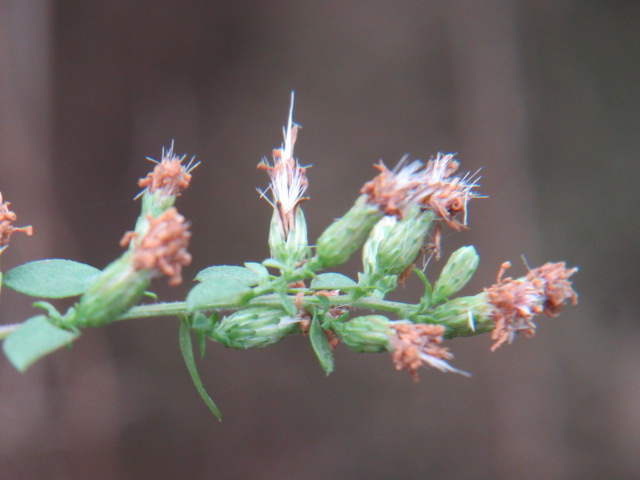
Symphyotrichum sp. ? on 10-25-21, #852-21.
What about the involucral bracts? Always check them out with members of the family Asteraceae. They can be appressed, recurved, in multiple rows (ETC.) depending on the species, subspecies, or varieties. In the particular species I am debating, they are appressed this in the above photo.
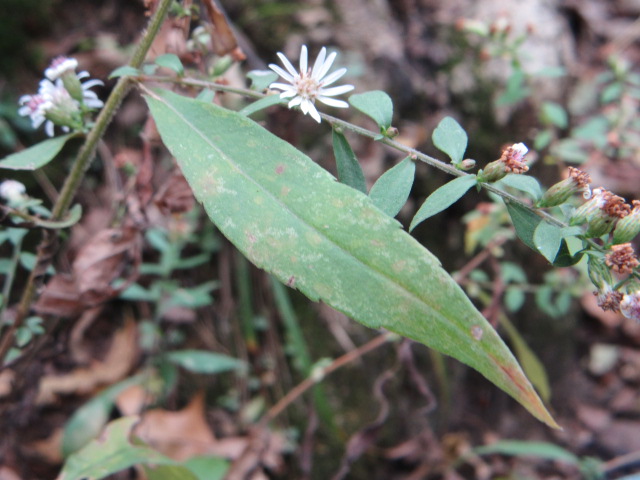
Symphyotrichum sp. ? on 10-25-21, #852-24.
There are very few of these longer leaves on any of the plants. Most of the lower leaves (basal) fall off on many species during flowering, while the upper leaves are much smaller. Missouri Plants lists 17 species of Symphyotrichum in the state of Missouri. However, they DO NOT have the species I am debating but they mention it as a “look-alike” of S. lanceolatum… I checked the map on the USDA Plants Database for Missouri and the species is supposedly found in many counties but Pettis (where my farm is) is not one of them. It shows they are present in all the counties next to Pettis, including Henry which is across the street… But, you know, they base their evidence mostly on dried, pressed specimens collected many years ago. I checked the BONAP map, which was updated in 2014, and it appears Pettis may be on the map. I say “may” because it is very hard to tell… The species has 60 synonyms and its current scientific name wasn’t accepted until 1982…
So, what species am I debating? Well, I looked at a lot of photos on iNaturalist and several other websites and I found one photo with leaves similar to the plants I had found. It was from an observation that was made by an iNaturalist member in 2013. Fortunately, it was from someone I had contacted before about another species who just happens to be one of the curators. She didn’t know what it was at the time, so she contacted another curator who was good with the genus. I sent her a message and she suggested I contact them as well. SO, I did. I told them I thought it was possibly Symphyotrichum lateriflorum (Calico Aster) and sent links to the observations. They agreed and explained a few things in a reply.
<<<<+>>>>

Symphyotrichum ontarionis (Ontario Aster) on 10-25-21, #852-20.
Then there was this plant growing close to the fence behind the pond which I thought was likely Symphyotrichum lanceolatum (Panicled Aster). It is the one the debatable species is a “look-alike’ of and they both grow in the same type of wooded environment. BUT, when I contacted the iNaturalist member, they suggested it was Symphyotrichum ontarionis (Ontario Aster) but it could also be an aberrant S. lateriflorum. I agreed with S. ontarionis and the observation became Research Grade.
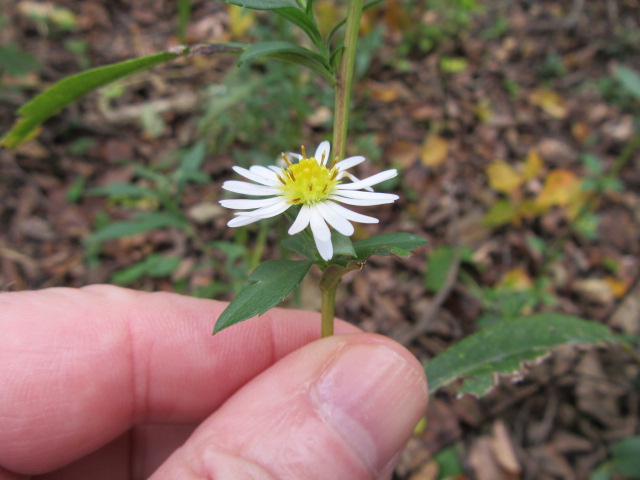
Symphyotrichum ontarionis (Ontario Aster) on 10-25-21, #852-22.
The flowers are similar at this stage and the disc flowers will change color as with “the other” species. It is possible they are the same species but I can’t determine that until 2022.
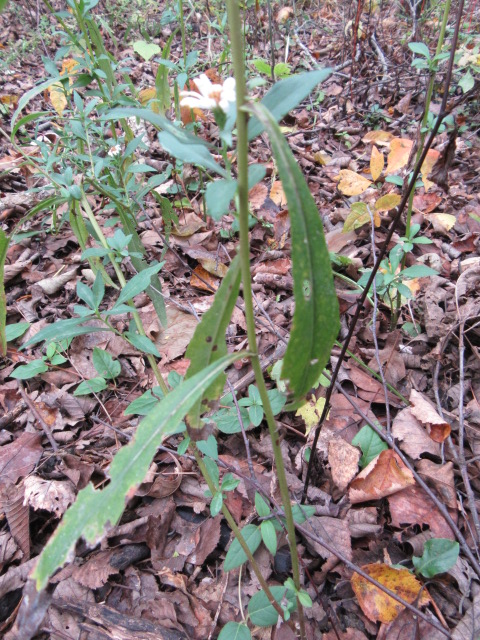
Symphyotrichum ontarionis (Ontario Aster) on 10-25-21, #852-23.
There were still quite a few long, narrow leaves on this plant but the upper leaves are completely different than those on the Symphyotrichum lateriflorum along the ditch… That doesn’t mean they still can’t be the same species.
I apologize for not writing complete descriptions of this plant’s stems, leaves, and flowers. I have a lot of photos to add I took over the summer, several species pages to write, and updates to make. It is a wintertime project but I do get behind. There are several links below with great descriptions. I will write descriptions as soon as I have time.
HMMM… I forgot to take a photo of this plant’s involucral bracts… GEEZ!
I am using the species name Symphyotrichum lanceolatum for this plant because it was the first name suggested when I uploaded each photo individually on iNaturalist. I read about the species and looked at A LOT of photos before agreeing with that name then I submitted the observation as such. Still, even though there is a name attached, it is unlikely any members will agree. I may have to seek out someone who has posted observations of the “debatable” species that have become Research Grade to get their opinion.
Sometimes a species can grow weird leaves when under stress, like when a deer eats the top off of the plant or its leaves. That could be the case with the debatable plant… So, now I am in the waiting game…
UPDATE on 10-27-21: This species has been confirmed as Symphyotrichum ontarionis (Ontario Aster) by one of the curators of iNaturalist. The curator said it was either S. ontarionis or an aberrant S. lateriflorum. We went with S. ontarionis for the moment and the observation is now Research Grade as such. 🙂
<<<<+>>>>
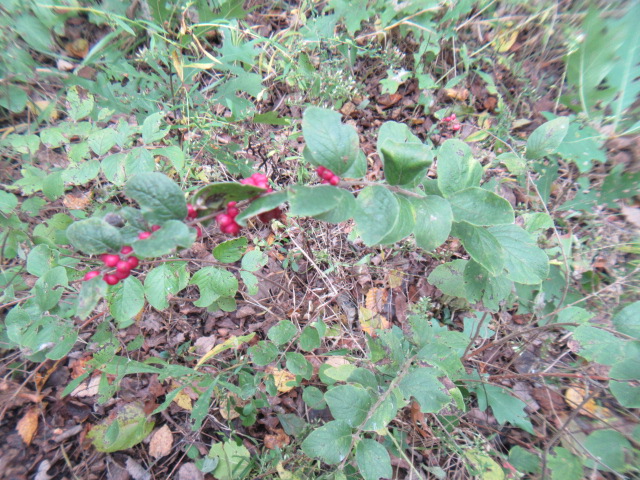
Symphoricarpos orbiculatus (Coralberry) on 10-25-21, #852-10.
Besides the species I photograph and get an ID of, there are hundreds (probably thousands) I overlook for one reason or another. I have been tromping around the area between the back pond and the fence since I was a kid. Climbing over dead trees, crawling under limbs, and pushing rose vines out of the way just to get through this area. It has always remained a natural habitat and always will be as long as I am here. There is quite a diversity of species all around this area and across the fence along the creek on the neighbor’s side (which used to be my grandparents). The Symphoricarpos orbiculatus (Coralberry) have been here a very long time.
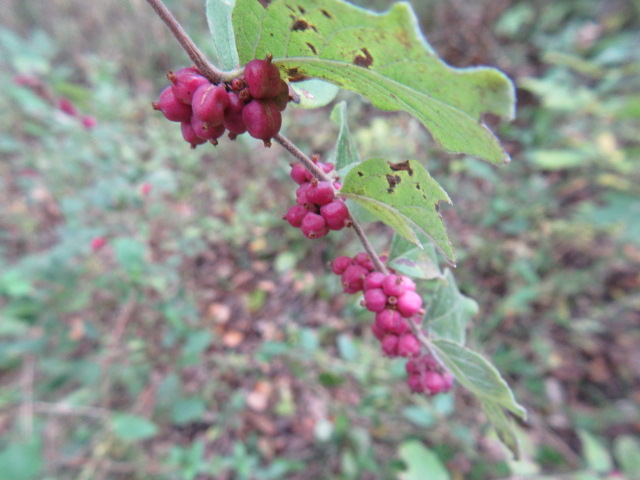
Symphoricarpos orbiculatus (Coralberry) on 10-25-21, #852-11.
Symphoricarpos orbiculatus is a member of the plant family Caprifoliaceae along with honeysuckle with arching branches. They thrive in a wide variety of conditions in the central and eastern half of North America from Canada down into Mexico. They are an arching, suckering shrub that produces bell-shaped flowers in the summer and fruit (called drupes) in the fall. I have not seen their flowers because I likely hadn’t been to the area during that time or just ignored them. Information says a wide variety of birds and small mammals eat the fruit and “browsers” use the plant for food…
<<<<+>>>>
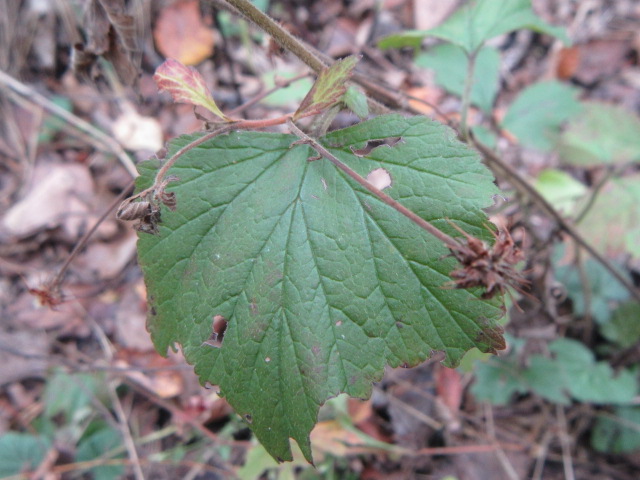
Geum canadense (White Avens) on 10-25-21, #852-9.
In the same area I saw this leaf that looked like it was from a grapevine but it had these weird seeds growing from a petiole in the axial. Then I remembered it was likely Geum canadense (White Avens). Without flowers, it is sometimes difficult to remember what you find this time of the year. This is the same area where I first identified this species in May of 2018. I have since found them growing in other areas.
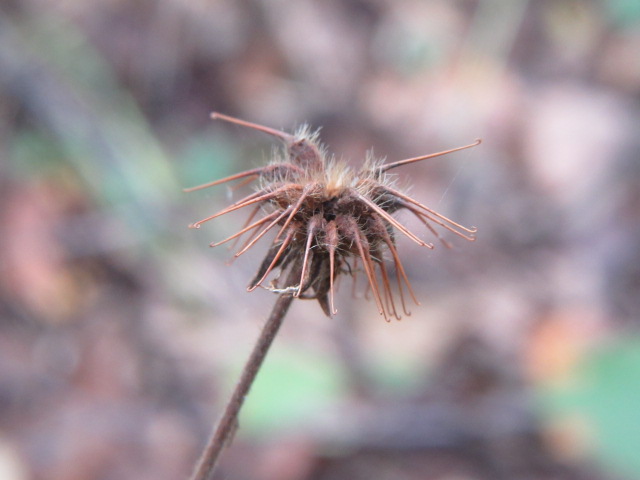
Geum canadense (White Avens) on 10-25-21, #852-8.
I was glad to be able to get a good photo of the dried achenes with hooked tips…
The next observation on the 25th made me very happy…
<<<<+>>>>

Elephantopus carolinianus (Leafy Elephant’s Foot) at 37″ tall on 10-25-21, #852-4.
I continued walking south toward the end of the area where I spotted a very suspicious looking plant… I looked it over very well and was almost getting goosebumps. OK, so it was a little chilly and the wind was blowing. I looked around and found a bigger patch with several plants… Could it actually be???
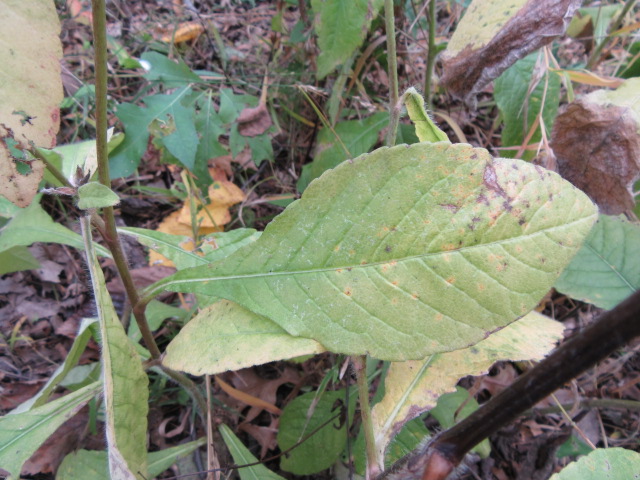
Elephantopus carolinianus (Leafy Elephant’s Foot) on 10-25-21, #852-5.
I checked the leaves, and sure enough, these plants are definitely Elephantopus carolinianus… WHAT A FIND! During the summer I don’t hardly ever get a chance to walk to the back of the farm because the grass in the hayfield gets so tall and thick it is hard to walk through. As a result, I missed these growing and flowering. Even when I did venture to the area I hadn’t walked through the spot I found them. Now that I know, there will be nothing to stop me next summer.
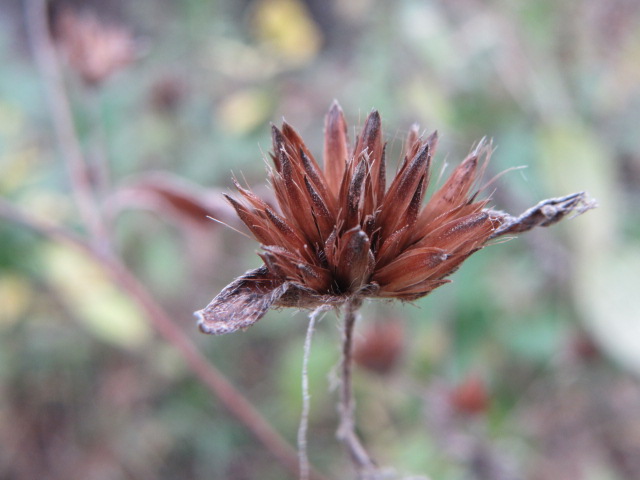
Elephantopus carolinianus (Leafy Elephant’s Foot) on 10-25-21, #852-6.
And we have seed… The bracts fall off rather than just the seed falling out.
I am very happy now to find a good-sized colony on my farm. This is a very interesting species for sure.
After that, I walked back to the house.
Maybe next year, maybe even this next week, I will take the mower and mow a path around the farm to areas I want to keep an eye on. That sounds like a good idea to me. 🙂
Until next time… Be safe, stay positive, and always be thankful.
